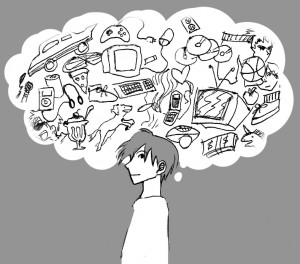Students have potential to add substance
As college students, we have a tendency to get bored. Really bored.
But you can’t blame us — our society today suffers from a hyperactive attention span, which has become problematic to say the least.
Just take a look at the present state of popular culture.
Audiences fixate on the latest thing in entertainment one day only to drop it the next. Ironically, however, the public’s rabid A.D.D. has done nothing to motivate industry leaders and entertainers to step up and foster originality.
In the past half century, new platforms like video games and the Internet have mildly held our attention, while music, film and other conventional forms of entertainment culture have witnessed a steady decline in innovation. Sadly, the advent of technology in the past decade has done little to alleviate America’s hysterical boredom.
The entertainment industry as we know it seems to have taken a turn toward flash in the pan trends with no foreseeable cure in sight. Desperate corporations have pulled out all the stops, producing anything remotely gimmicky or flashy in their attempt to temporarily hold ratings and make a quick buck on a sub-par idea.
Case in point: MTV’s The Hills franchise — the part-reality, part-scripted account of beautiful 20-somethings living in Los Angeles — has garnered millions of viewers during five choppy seasons. Like many of the network’s shows, what it lacks in genius, it makes up in distraction factor.
The fierce explosion of reality programming has been marked by a heavy reliance on controversy, catfights and human degradation to divert our attention. If programs like the indulgent Flavor of Love and its countless spin-offs are any indication, this strategy is working.
As a consequence though, substantive talent has been replaced with a superficial shine ready to burn out in 15 minutes or less.
Surprisingly, consumers are buying into it — for now. Although nothing seems to amuse us anymore, college students can actually be a much-needed change of direction.
At USC and other college campuses across the country, there is a glimmer of hope. Singers, actors, dancers and entertainers populate the college environment, creating what could soon be a refreshing breath of talent.
Hip-hop and break dancers from competing teams like Chaotic 3 and Break Through, vocalists from a capella groups like Reverse Osmosis and SoCal Vocals, and performers from the USC’s School of Theatre and the Thornton School of Music follow eagerly in the pursuit of quality entertainment.
Collegiate organizations, which are committed to developing the arts in areas such as music, film and more, offer an organic level of training much different from the corporate practice of churning out recycled ideas.
Students perform at open mic nights at Ground Zero Café, compete in dance competitions throughout Los Angeles, create movies and upload their musical repertoires on YouTube. With USC’s thriving artistic culture, stars might very well be walking among us.
Still, entertainment culture continues to be successful as the demand still exists and our tastes have shifted accordingly. But the public’s newfound preferences coupled with a hyperactive, bottom line-obsessed industry is crushing space for true art and demands a need for resurgence.
Schools like USC can ensure this happens by continuing to provide greater opportunities and outlets for creative expression outside of traditional academic rigor.
Even at USC, which has benefitted from its connections to Los Angeles and Hollywood, there is potential for growth. For instance, while the school features strong arts-related programs and student organizations, it has yet to adopt a dance major.
In the search for worthy entertainers, the American audience is fickle, indecisive, bored and everything in between. Ungrounded ideas, which begin with just a sliver of cultural relevance, blow up to become nothing but smoke and mirrors. If boredom and disinterest is our insidious sickness, the growing pervasiveness of popular entertainment without true substance is the epidemic.
The question is now whether or not this generation stands in the position of establishing an entertainment culture with longevity or lasting appeal. Does current pop culture stand a chance at affecting social progress?
With young fresh college students at the forefront, the answer is yes.
Christopher Agutos is a junior majoring in political science and public relations. His column” Pop Life” ran every other Tuesday.


While USC does so much to develop substantial growth, it occasionally gets distracted from its goals and feeds us notoriety over quality and perpetuates our bad consumer habits. When Program Board announced that T-Pain – the quintessential superficial hustler with the least amount of artistic talent at the entire event – would headline Springfest 2010, a part of my soul died. Despite the plethora of amazing acts throughout the day including Antonio Pontarelli who blew me away with his epic set powered by his electric violin, the quad remained a desolate place throughout the day. Yet, when T-Pain was on stage, a mob amassed on the lawn as he danced his way through an incredibly under-whelming set. If I wanted to see someone dance, the street performers on Venice or Santa Monica would have put on a better show. As for the music, well, with the vocal tracks louder than T-Pain’s mic, I might as well have just gone to a club where a DJ could have mixed together a much stronger T-Pain medley without the braggadocio.
And this is what our tuition dollars are going towards? I wonder what President Sample would have thought if he watched a recording of this concert…
Anyways, the point is that record companies and USC promote these artists because its what the people like. When art becomes corporate, consumer preference dictates the market, so if we want to see quality artists being rewarded in pop culture, let’s start with the man in the mirror.